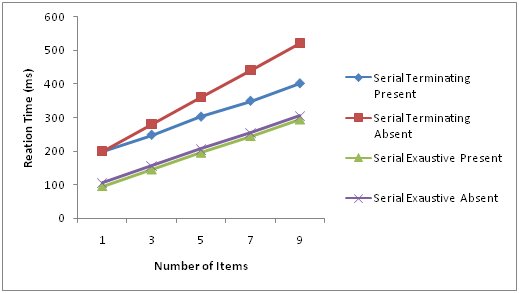Chapter 1. Sternberg Search
1.1 Introduction
Sternberg Search
You are remembering a very short list of items that you can hold in your memory at one time. Perhaps it is a short list of gifts to buy for a friend. You then see something in a store and you need to determine if this item is on your list. You don’t have it written down, so you search your short-term memory, also known as working memory. The present experiment was designed by Saul Sternberg (1966) to determine how we search our short-term/working memory.
1.2 Experiment Setup

1.3 Instructions
Instructions
You will need to press the space bar to begin the experiment. At the beginning of each trial, a fixation mark will appear. Please look at this mark. After it is removed, there will be a blank screen for one second. Then a short list of numbers will be presented for you to remember. The list will be 1, 3, or 5 items in length. The longer the list, the longer you will be given to memorize it. After the items are removed, there will be a blank screen for two seconds and then a probe item will be presented. Your job is to indicate if the probe was in the list you had to remember. You will be given answer feedback. Please be as accurate as you can while responding quickly to the probe. Use the keys shown below or the buttons on the screen for your responses.
| Keyboard Response | What the Response Means |
|---|---|
| j | The probe is in the list. |
| f | The probe is not in the list. |
1.4 Experiment
Begin Experiment

1.5 Results
Results

1.6 Debriefing
Debriefing
The longer the list of items, the longer it takes to determine if the probe is in the list. More than that, how much longer it takes fits a straight line extremely well. The correlation coefficient would be nearly perfect. To help understand these results, it is useful to review different ways a search can be done. The two basic types of searches are serial and parallel. In serial search, you look at one item at a time before looking at the next item. In parallel search, you can look at all of the items at once. In serial search, as you have more items to look at, the longer the search time. In parallel search, your search time does not change as you add more items to distract you from the item you are looking for.
Since reaction time goes up for more items, we can conclude that we do a serial search in our short-term memory. But there are two ways we can do a serial search: serial terminating and serial exhaustive. In serial terminating, you stop your serial search when you find the item you are looking for; in serial exhaustive, you search all the items no matter when you find the item. It is possible to distinguish the different types of serial search by looking at reaction times from when the target is present and when the target is absent. Consider this situation: If you are doing a serial terminating search, you finish the search as soon as you reach the item you are looking for. Sometimes that item will be the first item you find and you will stop really fast. Sometimes you have to look through all of the items to find your target. If the item is not present, you always have to look at all of the items. On average you will finish the search when the target is present sooner than when the target is absent. You will find that the longer the list, the bigger the difference between the two reaction times. You get a V-shaped reaction time, as shown in the figure below for the two serial terminating conditions.

In serial terminating, you search to the end of the list no matter when you find the target. There is little if any difference between when the target is present and when it is not. This outcome is shown in the two serial exhaustive lines shown above.
The results from the Sternberg search match the serial exhaustive pattern much better than the serial terminating pattern. Thus, it seems that in our short-term memory we search to the end even if we find the target at the beginning of the list. It is interesting to speculate why we do that, since seems a waste of time -- not very much, admittedly, but still it is a waste.
References:
Sternberg, S. (1966). High-speed scanning in human memory. Science, 153(3736), 652-654.
Sternberg, S. (1969). Memory-scanning: Mental processes revealed by reaction-time experiments. American Scientist, 57(4), 421-457.
1.7 Quiz
Quiz